Inspiration in 5th Edition is a really cool mechanic for encouraging roleplaying. According to the Player’s Handbook:
Inspiration is a rule the Dungeon Master can use to reward you for playing your character in a way that’s true to his or her personality traits, ideal, bond, and flaw.
Although it’s designed to allow a DM to reward their players for character driven approaches to problem solving, it is often used to reward quick thinking or spectacular outcomes. The rule is well-balanced and flows well in gameplay, but as a DM it can be difficult to remember to give out inspiration in the middle of a session, or even what to give it out for. This can lead to players hoarding their inspiration since they never know when they’re going to get another one, and often times players will end the session never having used their inspiration, rendering the whole concept moot.
In an effort to try and fix this issue, friend of the project, Dave and I created a slightly modified version of the Inspiration rules and we’ve been playtesting them in multiple games now for a few months. We’ve generally found that DMs tend to give out more inspiration and reward more diverse kinds of roleplaying than when we were using the normal rules and because of that, players more freely use their inspiration during play.
Flavors of Inspiration
In our new system, Inspiration comes in five different flavors which both Dave and I denote with Magic the Gathering lands that we keep behind the DM screen, along with a paper key (which you can see in the picture). A player earns inspiration based on what kind of action they took:
-
Backstory (Green): A player can earn a Backstory Inspiration card if they roleplay a situation that is heavily influenced by, or gives some indirect insight into their character’s background. This can be something like telling a personal story while the party sits around a campfire or during a religious confession.
-
Flaw (Black): This is one of my favorites. A player earns Flaw Inspiration for roleplaying a possibly contentious character flaw. Maybe their character is too distrustful and sabotages the mission, or because of their thieving background, they hide crucial information from the rest of the party. In my experience, players don’t get enough credit for playing their characters fully when the character’s flaws hamper the rest of the party, and giving them Flaw Inspiration can help encourage them.
-
Combat Flash (Red): This is the kind of Inspiration that’s most commonly given out in a lot of games. Players get this kind of inspiration for flashy or awesome combat moves or really clever planning. This kind of inspiration is usually only for combat-related events.
-
Team Building/Camaraderie (White): Camaraderie Inspiration is given out when a player uses their skills or character traits to inspire or build trust with the other characters in the party. A character’s rousing, fireside speech, or brave leap into the path of an oncoming Witch’s Bolt to protect another party member would both be good examples of when to award Camaraderie Inspiration.
-
Intrigue (Blue): In the same way that flashy, awesome, or clever roleplaying can be rewarded in combat, Intrigue Inspiration rewards players for their slick persuasion, lurking stealth moves, or clever planning outside of combat. In my experience, this tends to be a really common one to give out.
Players are still free to pass inspiration to another player, and they still can only have one inspiration total, regardless of the type. The type only matters to the DM when they’re giving it out in the first place.
We’ve found that by separating out the kinds of things we want to encourage it helps us as DMs recognize when our players should get a certain kind of inspiration.
Try it, and let us know!
If you like what we’ve come up with, please try out these new rules in your games. If you find any issues or improvements, shoot us an email and let us know! we’d love to hear your thoughts on our changes or what other kinds of modifications you’ve come up with.


